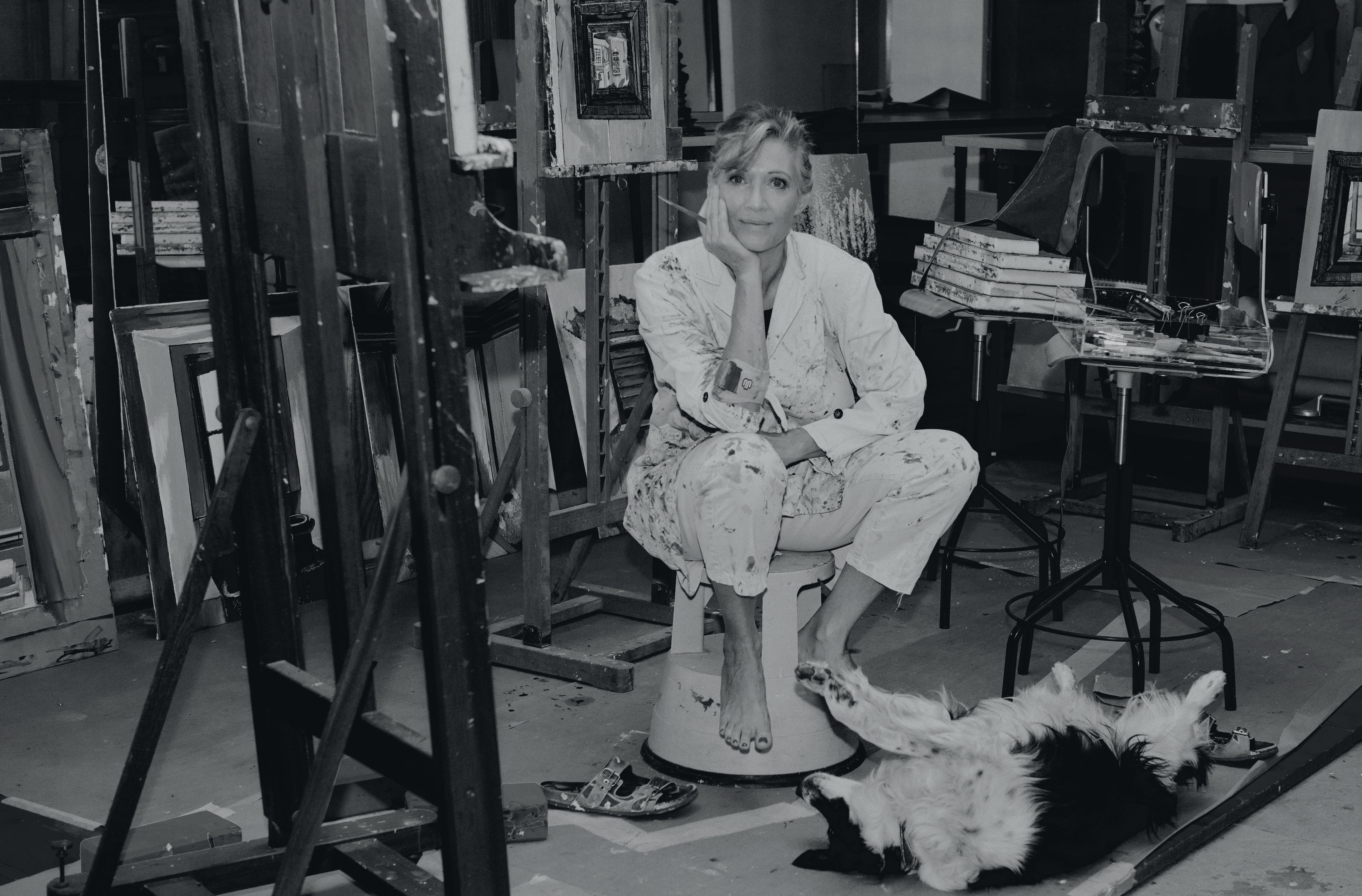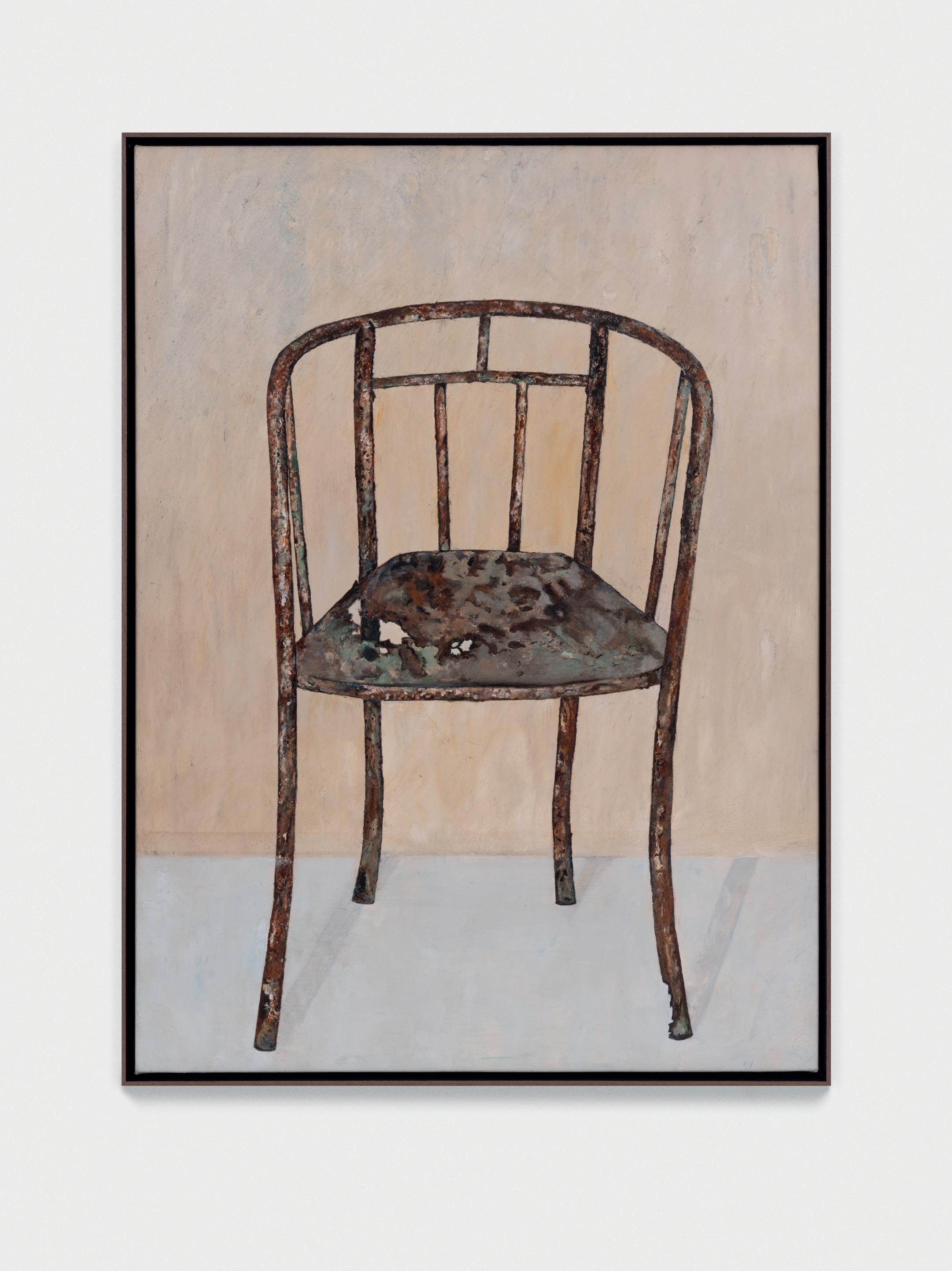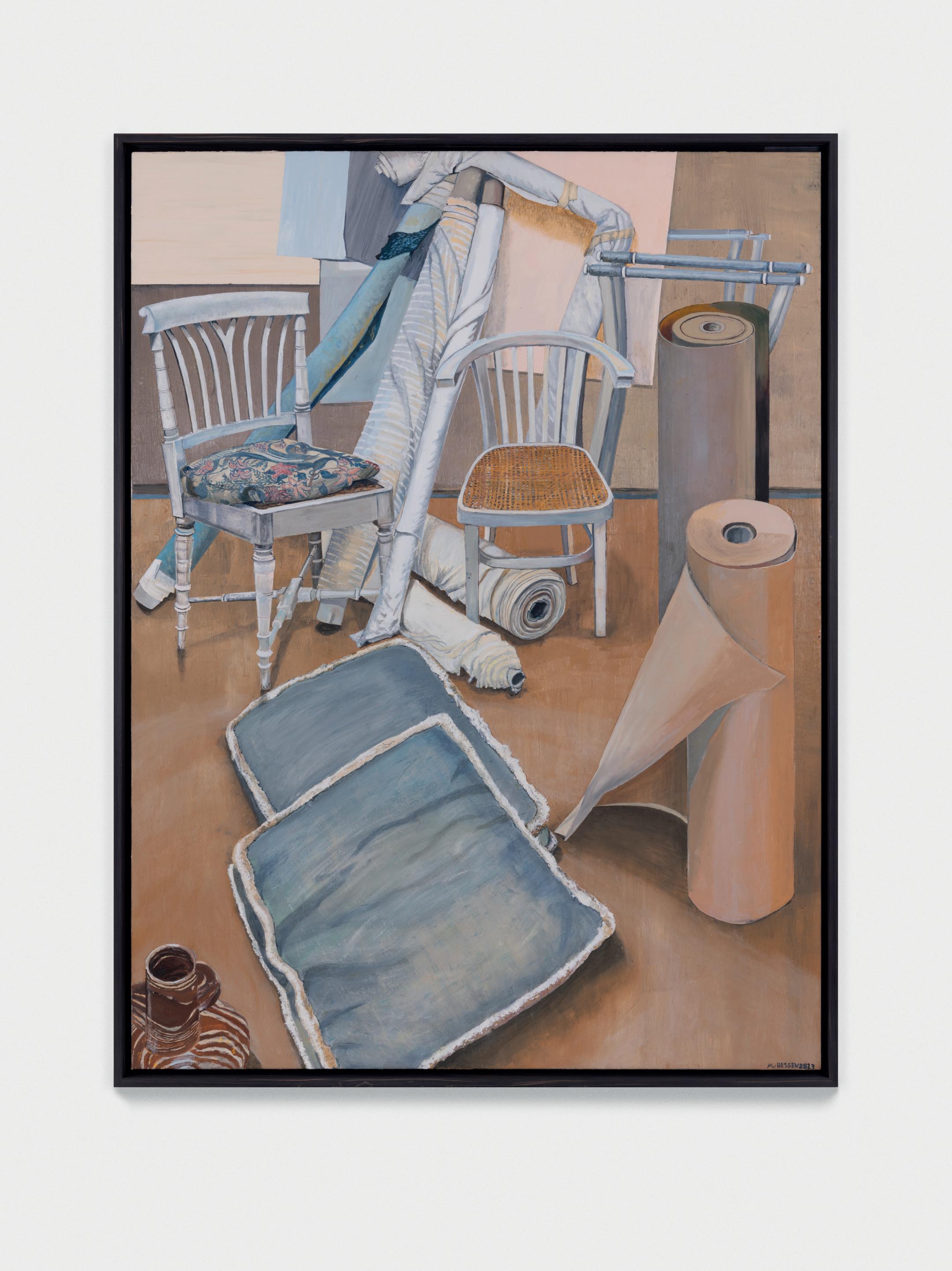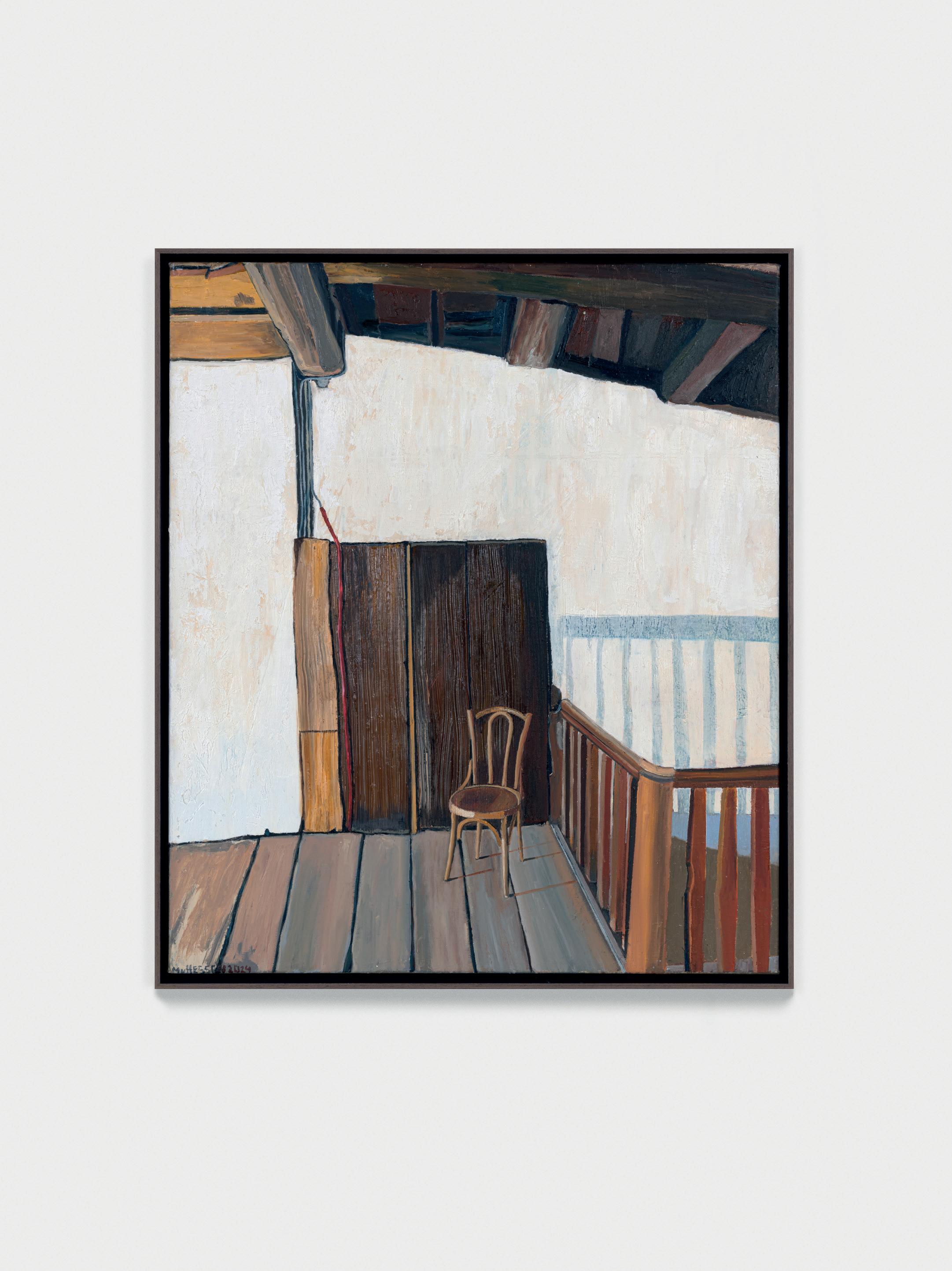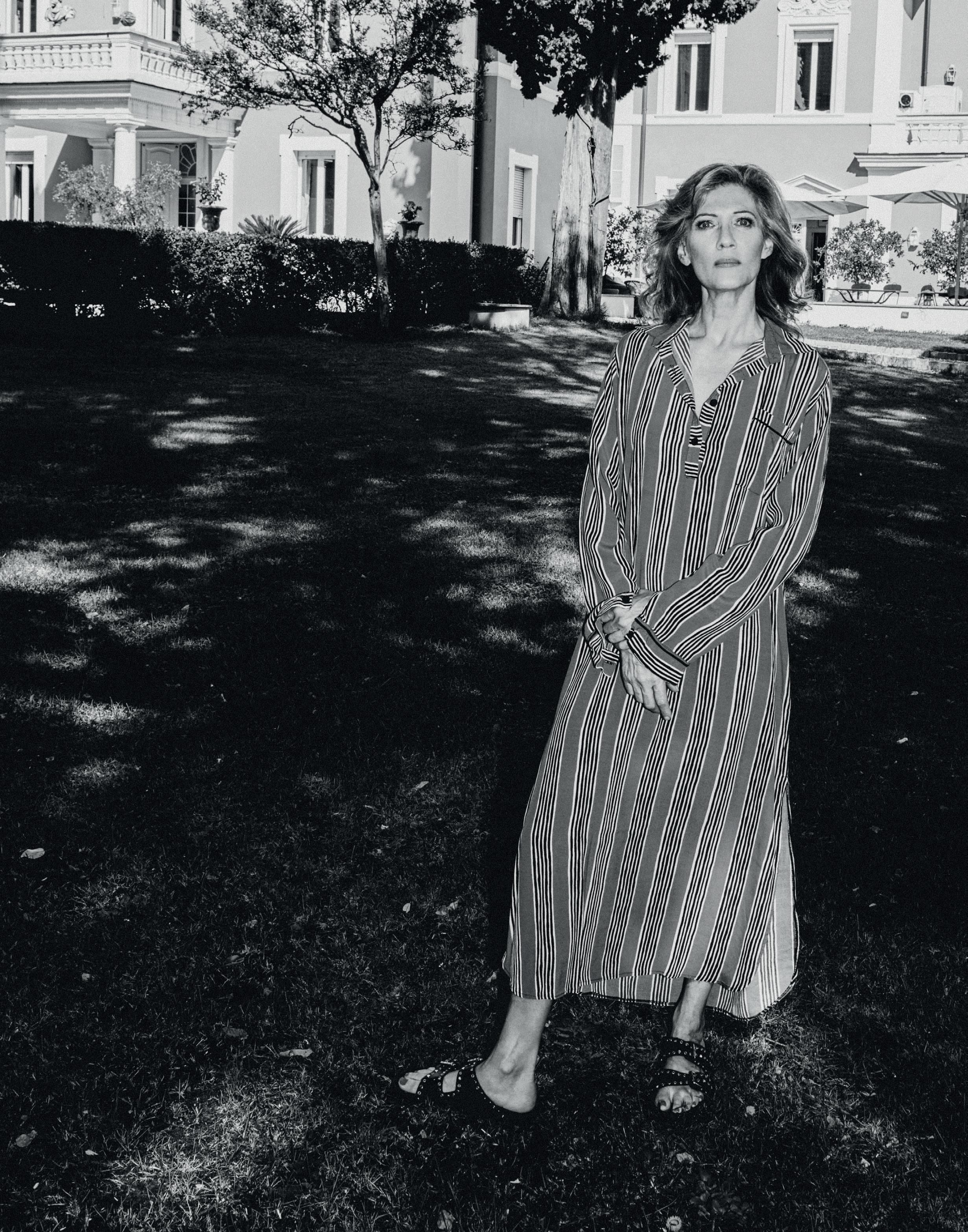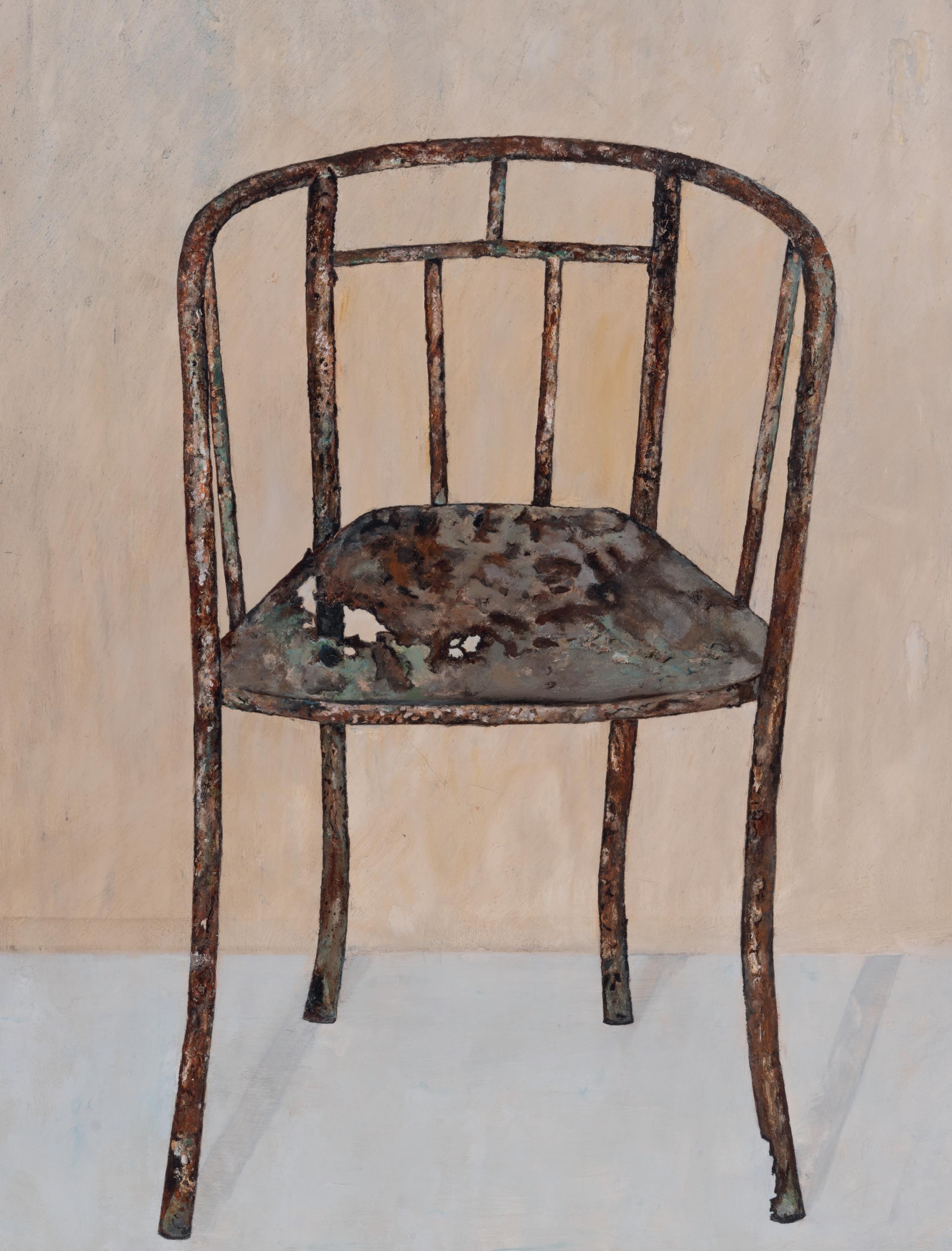
JGM GALLERY LONDON
LOOKING IN
EXHIBITING AT JGM GALLERY LONDON
AN EXHIBITION OF WORKS BY MAFALDA VON HESSEN
JGM GALLERY PRESENTS LOOKING IN A LONDON DEBUT EXHIBITION OF WORKS BY MAFALDA VON HESSEN. WHAT UNIFIES VON HESSEN’S WORKS IS THE OVERARCHING THEME OF ‘THE GREAT INDOORS’. DESPITE THE OSTENSIBLE SIMPLICITY OF THE SUBJECT MATTER, HER DEPICTIONS OF FAMILIAR REALITIES ENCOURAGE THE AUDIENCE TO PAUSE AND CONTEMPLATE THE POETICS OF THE EVERYDAY. THE PRACTICE OF REIMAGINING AN INTERIOR SPACE ESTABLISHES A SERIES OF DICHOTOMIES: THE FRAGMENT AND THE WHOLE, THE EPHEMERAL AND THE PERMANENT, THE MUNDANE AND THE NEW, INTROSPECTION AND ACTIVE CURIOSITY.
HAVING UNDERTAKEN A MASTERS IN COSTUME AND SET DESIGN AT NEW YORK UNIVERSITY, WORKED WITH THE COSTUME HOUSE TIRELLI, AND FOUNDER OF HER OWN FASHION BRAND, IT IS PERHAPS UNSURPRISING THAT VON HESSEN POSSESSES AN AVID FASCINATION WITH THE MATERIALITY OF OBJECTS. LOOKING AT HER WORKS IS AS THOUGH PEERING THROUGH A VIEWFINDER INTO A SNAPSHOT OF OUR INTERIOR LIVES. OBJECTS ARE INTRICATELY DECORATED, SURFACES ADORNED, AND WARM, VIBRANT HUES SUGGEST A CONVIVIAL ATMOSPHERE. BY CAPTURING THE EXAGGERATED SENSATIONS OF INTERIOR SURFACES AND TEXTURES, SUCH AS THE INTRICACY OF A TEXTILE OR THE COMPLEXITY OF LIGHT AS IT HITS AN OBJECT, VON HESSEN’S DEPICTIONS TRANSCEND THE BANAL, EVEN LENDING HER WORK A HEIGHTENED SENSE OF DRAMA. HER FIGURATIVE STYLE PERMITS AN ELEMENT OF COMPOSITIONAL FREEDOM; FURNISHINGS ARE DEPICTED AS LARGER-THAN-LIFE AND OBJECTS OF INTRIGUE ARE TRANSPOSED INTO UNFAMILIAR ENVIRONMENTS. AS SUCH, VON HESSEN CREATES A SENSE OF THE EXPANSE OF THE INDOORS, WHICH IS SEEMINGLY AT ODDS WITH THE INTIMACY OF HER CHOSEN SUBJECT MATTER.
‘LIVED IN’ SCENES, WHICH WOULD ORDINARILY SERVE AS BUSTLING SOCIAL SPACES, ARE INSTEAD DEVOID OF AN EXPLICIT HUMAN PRESENCE. YET, VISUAL SIGNIFIERS SUCH AS COATS HANGING ON A MIRROR, FOOD ON A TABLETOP, OR AN INDENT IN A CHAIR, HINT AT RECENT ACTIVITY AND SITUATE AN INTERPRETATION OF VON HESSEN’S WORK, NOT ONLY WITHIN THE POETICS OF SPACE, BUT TIME. WE ARE ENCOURAGED TO ASK THE QUESTION: WHAT IS ABOUT TO HAPPEN, OR WHAT HAS HAPPENED? IT IS THIS BUZZ OF LIFE, GESTURING TOWARDS HISTORY AND ANTICIPATING THE FUTURE, WHICH VON HESSEN REFERS TO AS THE ‘SOUL’ OF AN OBJECT. AS A RESULT, MATERIAL COMPONENTS BECOME CHARACTERS IN HER NARRATIVE, FURTHER ANIMATING THE SPACE AND SUBSEQUENTLY ENCOURAGING INTROSPECTION FROM THE VIEWER. A TENSION BETWEEN THE PHYSICAL AND PSYCHOLOGICAL ACTS OF ‘LOOKING INWARDS’ IS EXEMPLIFIED IN FRANZ WEST MEETS TANA. THE PRESENCE OF A BELOVED PET, NOTEPAD AND KEY, AID IN CONVEYING A SPACE WHICH IS CLEARLY PERSONAL TO THE ARTIST. THE SPATIAL INCOHERENCIES, HOWEVER, CAUSED BY THE IMPOSSIBILITY OF THE MIRROR AND ITS UNMATCHED REFLECTION, INTRODUCE A MULTIPLICITY OF GAZES. WE, THE VIEWERS, ARE INVITED IN.
JENNIFER GUERRINI MARALDI (DIRECTOR OF JGM GALLERY) SAYS THAT “I AM DELIGHTED AND VERY PROUD TO BE THE FIRST TO EXHIBIT THE UNIQUE WORKS OF MAFALDA VON HESSEN, HERE IN LONDON. EACH PAINTING IS EXEMPLARY OF BOTH HER PERSONAL CHARM AND THE VIBRANCY OF HER SURROUNDINGS IN ROME, WHERE SHE LIVES AND WORKS.”
CONTENTS
FOREWORD BY JENNIFER GUERRINI MARALDI 6
MAFALDA VON HESSEN IN CONVERSATION WITH CHLOE REDSTON
ARTWORKS WITH CURATORIAL COMMENTARIES BY CHLOE REDSTON
9 - 14
17 - 46
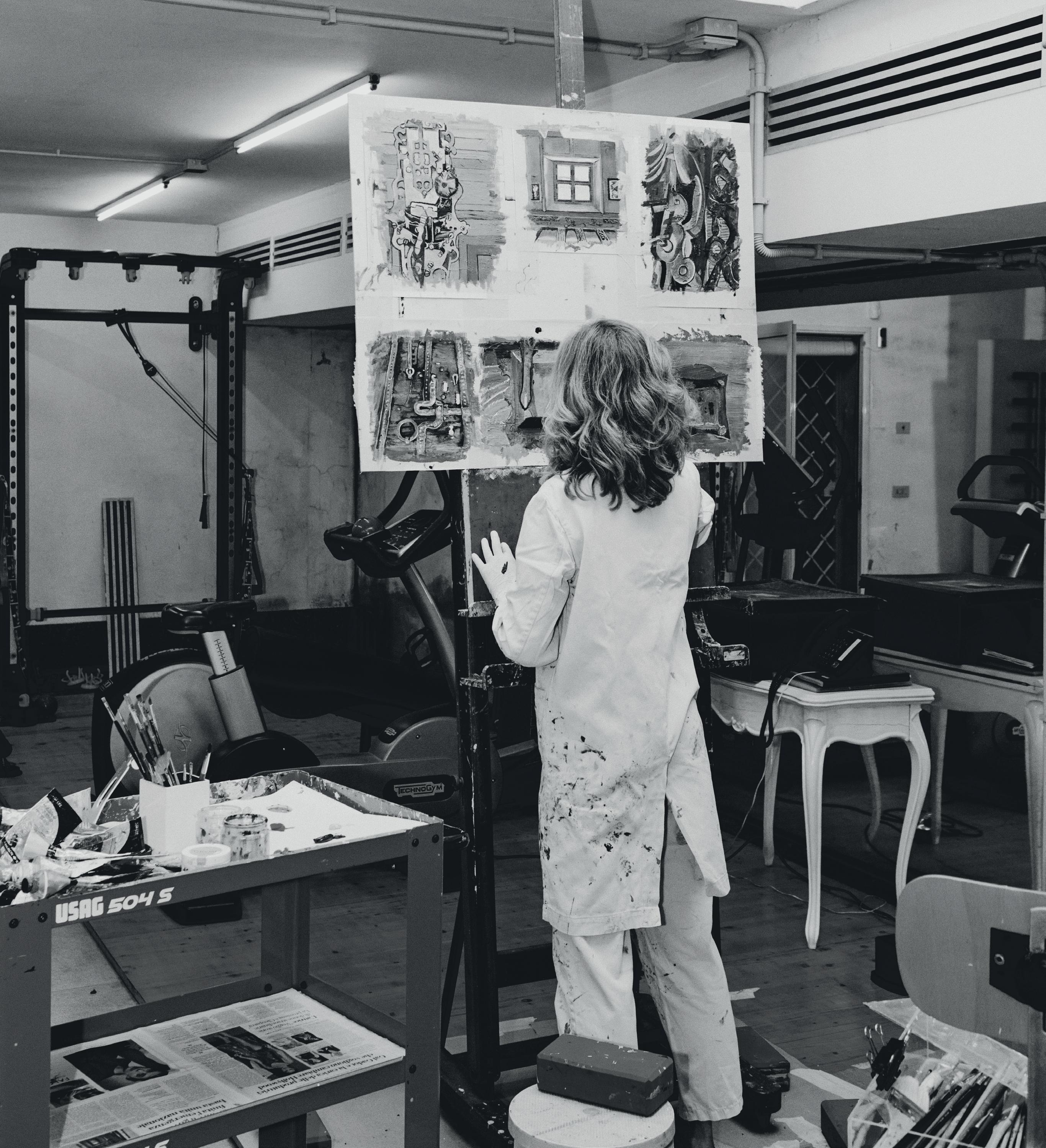
Mafalda von Hessen in her studio. Image courtesy of Pierluigi Macor.
17 APRIL TO 25 MAY 2024
LOOKING IN
1 2

3 4
Mafalda von Hessen, White Chairs & Packing Paper (detail), 2022, oil on canvas, 166cm x 126cm. Image courtesy of the artist.

FOREWORD
BY JENNIFER GUERRINI MARALDI
IT IS WITH GREAT DELIGHT that I introduce the work of Mafalda von Hessen, a dear friend and consummate painter. We welcome Mafalda to JGM Gallery for her inaugural London exhibition, titled Looking In
I have loved watching these paintings come alive on my numerous studio visits to Rome. In the curation of this exhibition, I felt so much of Mafalda's world reflected in her art practice. There is an openness and directness in this work –objects and forms move and rearrange themselves in her paintings, winking at each other from across the expanse of Mafalda's 'great indoors'.
Her paintings present a unique theatre of objects – the intertwined easels, plates piled on tables together with exotic patterned fabrics. It can be a lone chair that almost speaks to the viewer, or groups of objects arranged together to create visual tension, bursting with elegance and her sense of style. These works, in turn, shine a light on the vivacious personality of the artist.
Although a human presence is absent in most of these paintings, Mafalda's keen eye for the animate in the inanimate permeates the surface of each canvas. Perhaps this paint permits the disclosure of deeper dispositions and, in Mafalda's instance, an insatiable desire to question norms – compositional, psychological, or otherwise.
What are we really looking into when we view these paintings? Simple depictions of interiors, or metaphors for Mafalda's psyche, insight into a timeless observation – a realm where inanimate objects possess agency and an audacious curiosity.
These paintings are beautiful, magical, and honest. Mafalda strives to "... make the everyday poetic" and her London exhibition is testament to that end.
Jennifer Guerrini Maraldi. Image courtesy of Julius Killerby.
5 6
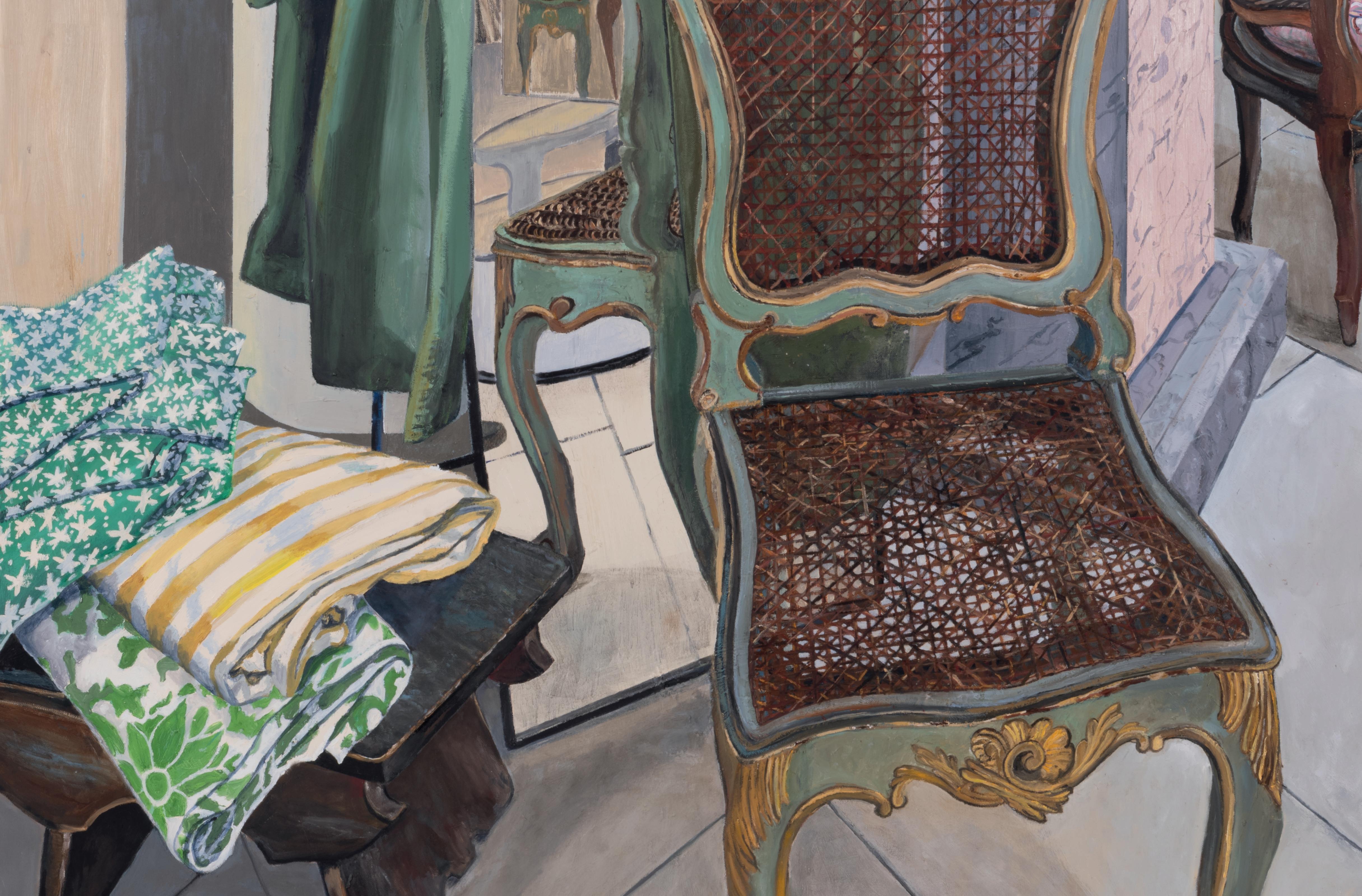
Mafalda von Hessen, Green Coats (detail), 2022, oil on canvas, 166cm x 126cm. Image courtesy of the artist. 7 8
The poetics of the
CHLOE REDSTON Mafalda, when did you first start painting? Is it something you’ve done all your life?
MAFALDA VON HESSEN I always had this urge to paint. I even still have the first painting I ever painted in kindergarten. It's also very figurative! Painting was always very important for me. I have done it all my life – from the age when I could hold a pencil until now.
CR In relation to the scenes that you depict, is there a kind of escapism element within the interiors?
MVH Well, in the beginning probably there was a sense of escapism. Especially when I was little. But now, I don't know, I just … I just need to do it. There were times where I didn't paint because I was a costume designer or I was doing my fashion or in a period of transformation between my marriages. In those times, I always felt that something was missing. I never felt complete as a person. It's like a vocation. A higher calling, if you will.
CR How do you choose your subject matter? What inspired you to depict scenes of 'the great indoors', and what are your biggest inspirations and influences?
MVH Usually it's very spontaneous. When I find something, I look, I take a photo. But sometimes I design the set – I did my masters in theatre stage and costume design. So it's always in me, this thing. And sometimes it's the object or the place which talks to me – so it's something very organic. If I have a com-
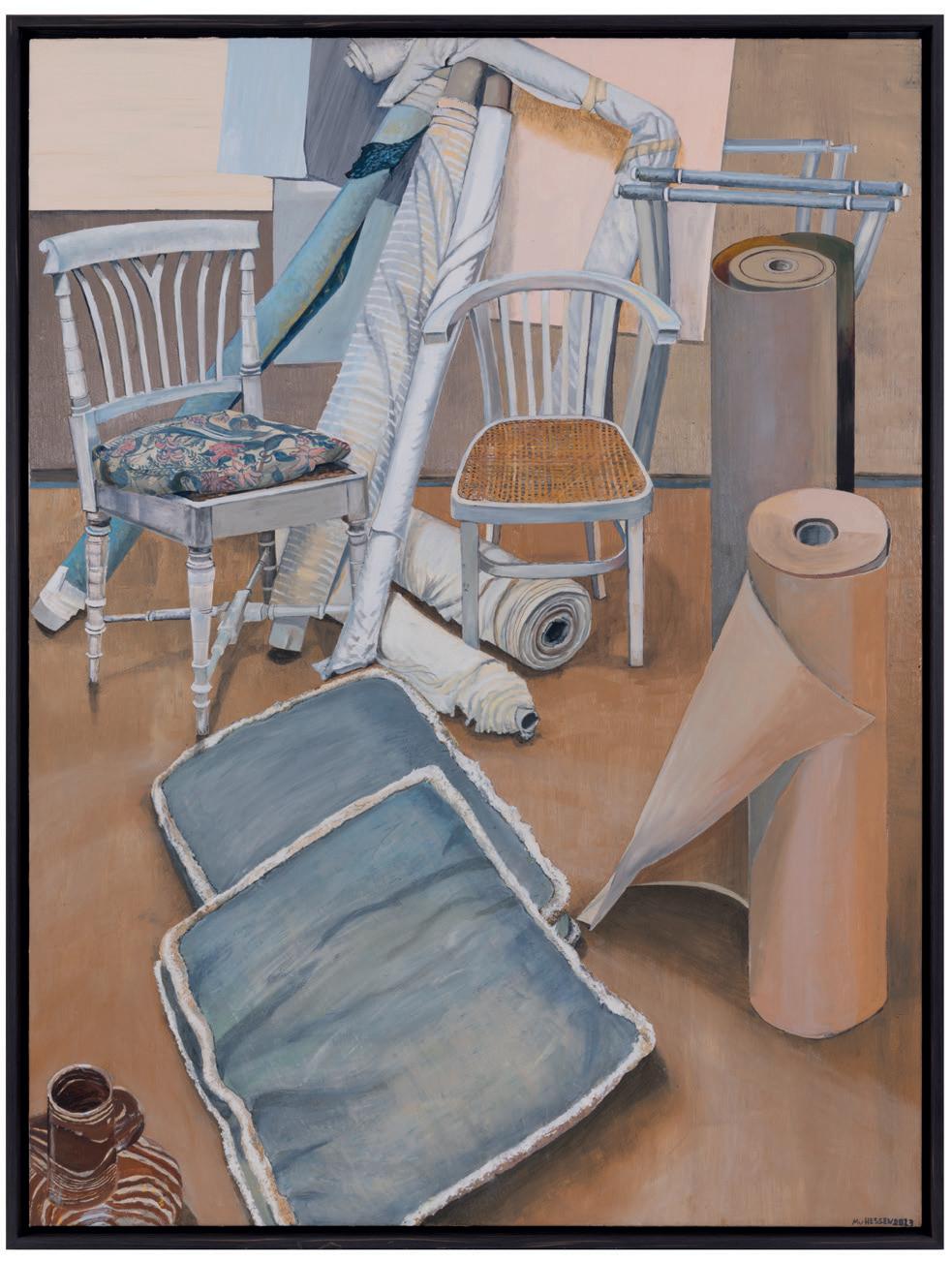
mission and somebody says “can you paint me or my environment” I still try to create an atmosphere which suits me. I get inspired by colours, by light, by the combination of the things put together. Of course, I often discuss it with Rolf or the person who's next to me. When I do a portrait, I talk to the person about what they want, which is very important.
CR What is the genesis of an idea and how does it progress and develop?
MVH I directly react to the people or the place. I choose the place or set it up. It depends on what it is – whether that be an interior, nature, or a portrait. They are three things which I approach differently. I love to be outside, I love to be in nature, and in that I take a totally different approach than I do to the interiors. Nature sometimes is so breathtaking, but so overwhelming, so big you can't take it all in. So my way around that is to concentrate on something small like a stone or a branch or something similar. When it comes to interiors, or objects, they talk to me. I want to portray them. For example, for me, chairs sometimes have souls.
I’m not sure how to explain it!
CR Are the interior spaces you depict personal to you? If so, what is your relationship to them? Are these spaces you inhabit or perhaps frequent, or are these a snapshot into the spaces of others?
MVH They can be both, they can be personal and they can be things which I see somewhere. I'm very discreet and very honest, so when I see something which I really like, I always ask for permission to take a photo – because not everybody likes to have their places represented in art without agreeing first. Sometimes I find that I look into rooms and they are totally untidy, or it's just storage, and there's dust everywhere – rooms like this I find amazing! But I can't paint that fast. I have so many ideas and I haven't got them all out yet!
CR You briefly touched on this previously, but are the scenes depicted in their organic state – do you find the scenes like this and attempt to solidify their transitory nature, or do you dress them intentionally for the purpose of representation?
MVH Both! I shall give you an example. I might come to an old house to survey it, I go to the attic and there's something beautiful and untidy in the middle of the room. I like it so much that I take a photo! Then I go home because there's an element that I find so intriguing, I must paint it and add my own interpretation. So maybe I create a different light, because the light was too cold, or too warm, or there aren’t enough shadows, or I want to alter the proportions and then I start working from there. The nice thing is with painting, although I'm very figurative and my education is very conservative, you can play with proportions, you can play with light, you can play with everything.
CR Could you describe your process and what you attribute to a feeling of introspection?
MVH When I first get into my paintings, or into the substance or in my vision – let's put it that way – I call the first stage embryos. I do little scribbles and then, from there, I do an A4 sketch. And then I prepare my canvas to which I have already applied colour. Then I do a sketch the same size as the canvas and then I get into my flow. I don't think, I just go with the flow until it's done. In the past, like 20 years ago or 10 years ago, I painted in the garden with my children. Now, with the COVID-19 pandemic, I started painting again because I had this urge. In the beginning it was quite tough for me because I had lost practice.
CR I just want to touch on what you said there about the pandemic – did your paintings of interior spaces coincide with spending more time indoors as a result?
MVH Yes, I’ll tell you why: I had a fear of painting. I knew that I had lost the practice. It's like somebody who wants to do a marathon but hasn't jogged in a long time and is afraid to start because it's so frustrating to start at the bottom, it takes you longer to get where you want to get to. COVID gave me time. We were all stuck at home. I started painting again. Everybody in my house had their own space and so on, and I started painting in my bedroom. It was so nice! There was this immense feeling of relaxation without the pressure. So, in the beginning, the paintings were very much of my own interiors.
CR There's also something to be said for finding beauty and finding the poetic in something that you are surrounded by every day, especially in circumstances like the pandemic where a lot of people felt trapped by their spaces. Finding the beauty in the objects that surround you becomes a form of escapism in itself.
MVH Yes, definitely. Definitely. Also, I feel like places or a moment or this millisecond sometimes it's as if they give me a wink! That moment, that light, that constellation of furniture or whatever.
CR I like that term you use – a ‘constellation of furniture’. It implies the organic in something that is materially artificial.
MVH Yes! They are not just pretty visions. My paintings are my personal perspective on ordinary and seemingly beautiful and unbeautiful places and objects in which I try to find my own harmony and grace.
CR To me, the subject matter of your work possesses a contemplative tone, bordering on the melancholic, which is seemingly at odds with the vibrancy of your chosen colour palette. Can you describe your use of colour and how it interacts with the mood of your works?
MVH Colour and proportion are of equal importance for me. Colour gives vibrancy and enhances the inexplicable mood of things – the mystery. I don’t often think about the colour at the time, I get into a flow, a meditative state, and when I step back from my paintings, sometimes I like what I have achieved, sometimes I scratch over it. My paintings have layers. What lies underneath may have a different colour or texture, sometimes this seeps through to the surface and sometimes it doesn’t. But in that sense, the act of painting becomes like modelling, and the paintings themselves morph into those objects I depict.
CR The title of your exhibition, Looking In, alludes to the intimacy of internal space both physically and psychologically but also implies that we, the viewer, as mere spectators are separate from this. Do you think this places the audience in a voyeuristic standpoint, or do you intend to encourage introspection from us as well – perhaps the two can coexist?
MVH I think they can coexist. First of all, I paint for myself. I don't paint for the spectator. So, if you gave me a commission, of course I would do my best to put the elements in which you desire, but I would still paint for myself! I'm very selfish at that moment when I am painting, it's more for myself than for
other people. Because otherwise it would be fake. Otherwise it wouldn't work, it wouldn't agree with me. So it's a natural, very organic, reaction within me.
CR The everyday objects you depict are often intricately decorated, perhaps even chaotic, whilst the furnishings are proportionately larger than life, giving the impression of the endlessness of the indoors. How do you think, compositionally, you create both a sense of vastness and, at the same time, intimacy?
MVH I just like to play with painting. In painting you don't have rules and that is my freedom. Why shouldn't I put some birds on a chair and the chair on the table? There’s no one who tells me I can’t do that! If I like it I put it in! In that, there is something comforting but also alienating. The compositional opportunities are endless, but that also reveals something about the inner workings of my mind.
CR For me, the intimacy of the internal space is juxtaposed with a feeling of distance, created by the unknown. An indescribable buzz of life and hints of recent activity, such as the coats on the mirror or an indent on a chair, situates an interpretation within the poetics of time, and yet, this notion is simultaneously dispelled by the underlying question: what is about to happen, or what has happened? What mood do you aim to create through these devices?
MVH Usually I try not to create a sterile scene. These devices for me generate a feeling of cosiness through the materiality of the inside, because, as you say, you feel that there's a person, or rather, there has been a person – there's a human touch to it. I myself don't want to limit myself to any singular interpretation. I am, of course, however happy when somebody wants to interpret something and project meaning onto any of my works. I am just playing, and in doing so, I give balance to my paintings through this suggestion of life.
CR Your approach to painting is clearly very playful. I find the juxtaposition of this feature of your work quite interesting because at the same time, it really encourages this kind of deep psychological reaction and introspection.
MVH Exactly. I have never asked a psychoanalyst. You look at me like a psychoanalyst does, which is fantastic. Maybe you are. You ask me questions and I think: yes, she's right! She's right! I've never seen my work in this light. I think, for me, it's much more spontaneous than anything, spurred on by a love of materials and surfaces. Sometimes, when I put up my ‘constellations’, as I call them, or I prop them up, I often have a specific element or object which I wish to incorporate, like a cloth of material or a coat, because I like the colour of the coat and it fits the composition. Sometimes they don't need to make sense, it's just what it is – what you see.
CR Similarly the hues often suggest a warm, convivial atmosphere, yet eerily the scenes are devoid of an explicit human presence. An air of anticipation for the human presence out of the frame, is reminiscent of, for example, David Hockney’s A Bigger Splash, or Patrick Caulfield’s interior depictions. Are these artists who have particularly inspired you?
MVH I have studied lots of artists and I love art myself. In my family, I have an uncle who was an artist, as is my sister. I grew up in an environment in which art was always talked about. Honestly, when I create, I'm very selfish. I'm thinking purely of the relationship between the canvas, myself, and what I want to depict. I'm not thinking of anybody else. Of course, I have studied art. But that’s not to say that I want to paint like Anselm Kiefer or like David Hockney or Hector MacDonald or whomever. It doesn't matter. I paint off an impulse. Otherwise I would be an imitator, an illustrator.
CR There is, therefore, a dichotomy present between the ‘lived in’ setting you
EvEryday 11 12
“When I paint one chair, for example, or one single object, it can talk to me. I think of the history. It is... as though I seek to imagine their life, their soul.”
- Mafalda von Hessen
create and the interruption of narrative through the absence of human life – and you touched on this with your reference to ‘constellations’ – to what extent are the objects themselves characters in your narrative? Do they tell their own stories?
MVH I see my objects like sculptures. When I paint one single object, for example one chair, it can talk to me. I think of the history. It is, as I said before, as though I seek to imagine their life, their soul. It is the interpretation of the lives of these objects which I seek to depict. It makes the everyday poetic. That's very beautiful I think. I see harmonies in both objects and in nature. I might paint one single stone or a branch. In a sense, the way I view the world and find poetry in the everyday is consistent no matter what the subject.
CR How do you judge the success of one of your paintings?
MVH I don't judge the success of my paintings. I am always proud of the result and I like that other people appreciate them. They are almost like people to me, I nurture and raise them from that embryo stage we spoke of, then a skeleton forms and I flesh them out until they are matured and finished. When I am finished, however, I move on. I can’t keep revisiting them because that always instigates self-criticism. I am my own harshest critic. Once finished, so to speak, I never usually retouch my pictures. When I look at them again, sometimes, for me, the perspective is totally wrong but everybody else loves it! I normally just think to myself, next time, I’ll do it differently.
CR I find it really interesting how you describe your process with such anthropomorphic terminology – in doing so you inject life into the inanimate object.
MVH Yes! I even talk to them!
CR Your works are painted with varying degrees of realism and representation. Some are more detailed than others. How do you know when to stop fine tuning the image? What determines whether a painting will be rendered realistically or less so?
MVH In the beginning I found this very difficult. As I said, my uncle was an artist. He used to tell me when to stop, but eventually I had to fend for myself. It’s like when you learn to drive, and the instructor is sitting next to you, and suddenly you find yourself driving all on your own. You never really know how it happens, but you get there! Sometimes a sketch, or a mere scribble, can be so powerful, and that speaks for itself.
CR Would you agree that there is a slight sense of absurdity in some of the arrangements, comparable perhaps to a kind of Magical Realism? I am thinking, for example, of the piece with a chair on top of a table with two birds.
MVH Yes, I love the freedom of setting up scenes. Don't forget, I'm a designer at heart (for the theatre) and I love it. It's like playing out a story, why not depict it? Why don't I put a random object into the painting? It is fun! Rolf also makes beautiful furniture and objects – sometimes I put them into my paintings as well. I also like to reproduce paintings by other artists within the paintings themselves. Sometimes, I see a beautiful room or environment, but I might not like the paintings which currently exist on the walls, so I substitute them for my own paintings! The freedom to do what I want with a painting turns into the magical, the absurd.
CR I notice that many of the objects in your interiors are on the verge of collapsing or falling, whether it be a pile of plates, a coat slipping off a mirror, or a pile of books too close to a table’s edge. For me, at least, this creates a subtle dissonance and a sense of anticipation, even trepidation – lending your work a heightened sense of drama. Would you agree with that analysis?
MVH Of course, you are correct. It creates a tension that makes the scene more curious. I have an anecdote from my father who loved interior design and landscaping. His father was also an architect. One thing my father taught me was that straight passes in gardening are always less interesting. Curves are more exciting. In a similar way, I play with my paintings. It may take me days to make an installation. I place things here and there, remove them and put them back again, trying to find the right balance. When I think I’ve completed it I start painting and think, I don’t like it! So I enhance the elements. There’s a playfulness throughout the whole process, from finding the object to arranging it to putting it down on the canvas.
CR What do you think distinguishes this body of work from previous paintings that you’ve made?
MVH Because I'm so figurative, I used to dislike how I paint. Now I have come to terms with it. I accept it, and I like it. I think this comes down to maturity. I still see myself going more abstract. My art is constantly evolving, and if you were to follow my first painting until now, and even in the future, I think we'll see there's a constant, natural evolution. In my mind I’m going abstract. Of course, I could attempt to paint like Pollock or the Abstract Expressionists now, but it would not be me. I wouldn't feel it. It's about what you feel. If you don't feel something, then it's dishonest. I think these paintings possess honesty.
Previous page: Mafalda von Hessen, White Chairs & Packing Paper 2022, oil on canvas, 166cm x 126cm Image courtesy of the artist.
Opposite page: Mafalda von Hessen mixing paints. Image courtesy of Pierluigi Macor.

13 14
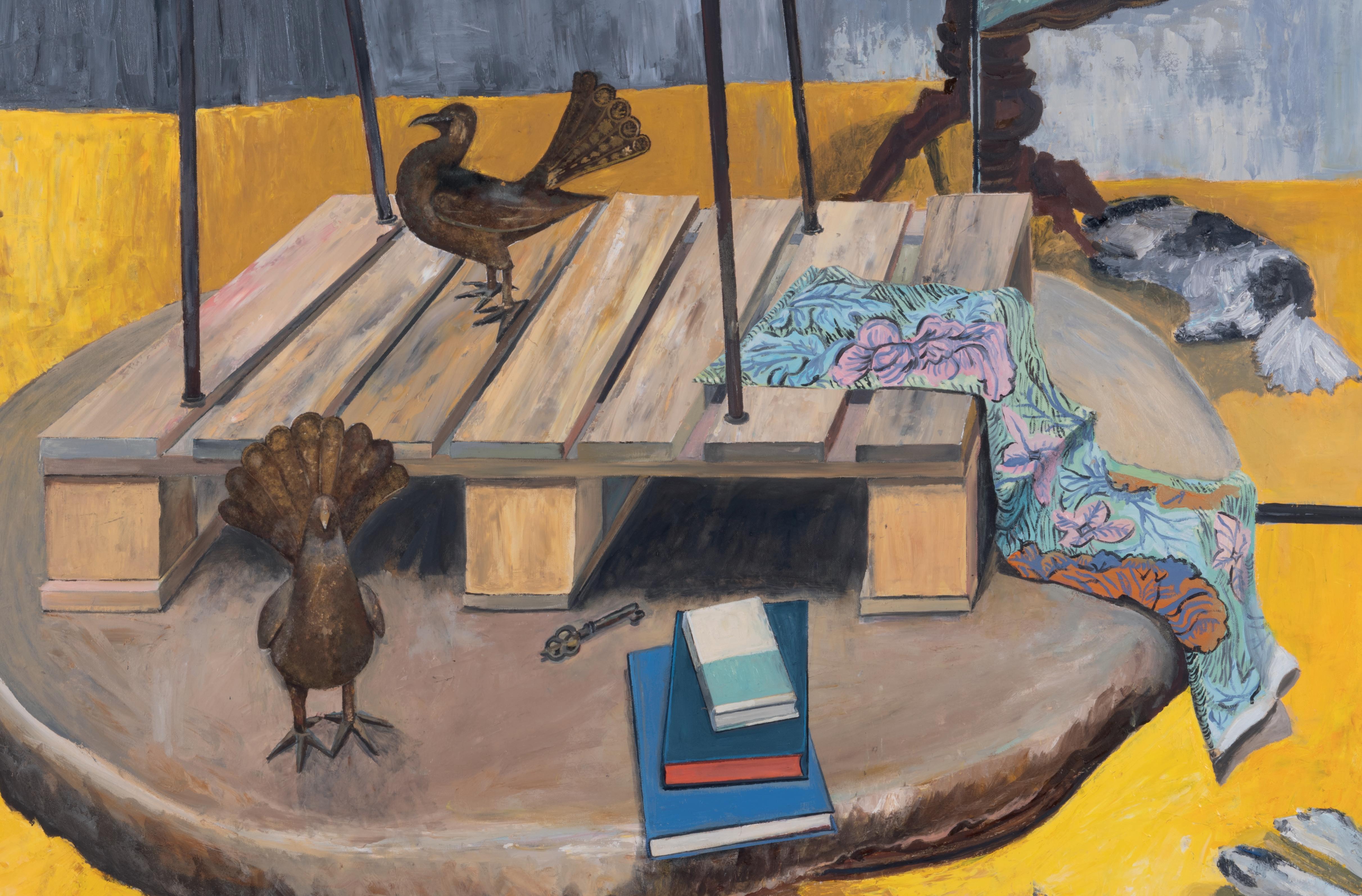
15 16
Mafalda von Hessen, Franz West Meets Tana (detail), 2022, oil on canvas, 166cm x 126cm. Image courtesy of the artist.






